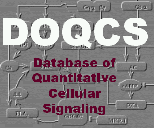 |

|  PP1_CaMKII_PSD PP1_CaMKII_PSD |
Enter a Search String | | Special character and space not allowed in the query term.
Search string should be at least 2 characters long. |
Accession information for AMPAR_CaMKII_weak_coupling (Accession Number 65)
Reaction Scheme

Accession Basic Parameters
| Name | AMPAR_CaMKII_weak_coupling |
| Accession Type | Network |
| Transcriber | Upinder S. Bhalla, NCBS |
| Developer | Arnold Hayer and Upinder S. Bhalla, NCBS |
| Entry Date (YYYY-MM-DD) | 2005-07-21 00:00:00 |
| Species | General Mammalian |
| Tissue | Neuronal |
| Cell Compartment | Synaptic Spine, Postsynaptic Density |
| Source | Hayer A, Bhalla US PLoS Comput Biol. 2005 Jul;1(2):137-54. Epub 2005 Jul 29. ( Peer-reviewed publication ) |
| Methodology | Quantitative match to experiments, Qualitative |
| Model Implementation | Exact GENESIS implementation |
| Model Validation | Replicates original data , Approximates original data |
| Notes | This is a model of weak coupling between the AMPAR traffikcing bistability, and the CaMKII autophosphorylation bistability. In this model, there are three stable states: Both off, AMPAR on, or both on. The fourth possible state: CaMKII on but AMPAR off, is not truly stable, since over the course of hours the AMPAR also turns on. |
Conversion formats
| Database compilation and code copyright (C) 2022, Upinder S. Bhalla and NCBS/TIFR
This Copyright is applied to ensure that the contents of this database remain freely available. Please see FAQ for details. |
|

